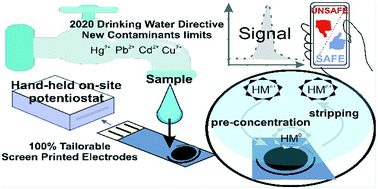Recent advances in portable heavy metal electrochemical sensing platforms
Abstract
In 2020, the new European Drinking Water Directive will be updated to include new drinking-water safety parameters. These will introduce reduced thresholds for the presence of heavy metals, pesticides and other contaminants in domestic drinking water. The aim of these reduced thresholds is to impose a higher level of consumer protection as well as provide guidance for effective monitoring, planning and water management. An example of a newly proposed threshold is the concentration of lead ions (Pb2+) within drinking water, which has been reduced from 10 to 5 parts per billion (ppb). The strict timeframe for water suppliers to meet the new thresholds has created an impetus to develop in situ detection techniques to quantify the levels of chemical contamination on-site in drinking water, allowing them to make prompt interventions. This review explores and discusses the current advances related to electrochemical methods, electrode materials and modifications that have the potential to be the foundations of a new generation of portable electrochemical sensors towards trace-level ion in situ heavy metal sensors.

- This article is part of the themed collections: Environmental Science: Water Research & Technology Cover Art and Best Papers 2020 – Environmental Science: Water Research & Technology


 Please wait while we load your content...
Please wait while we load your content...